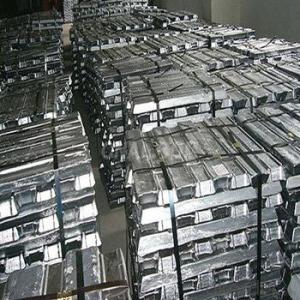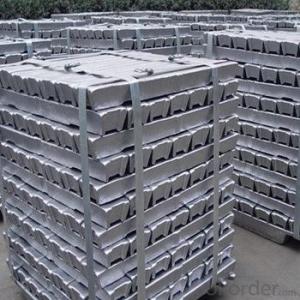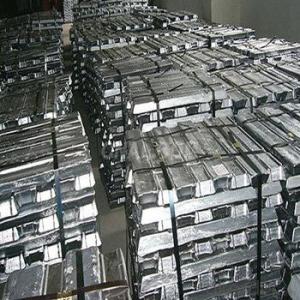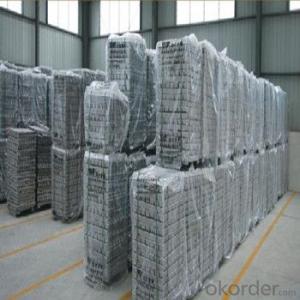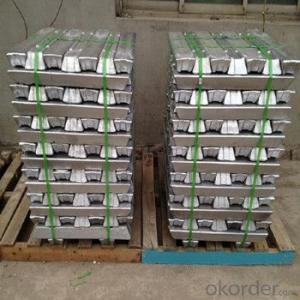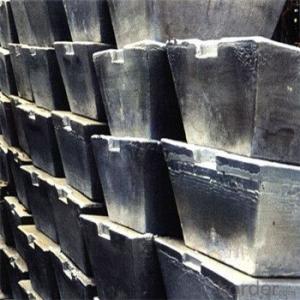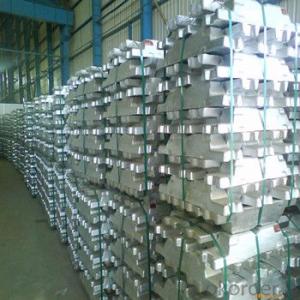Aluminium Ingot with Good Quality and Best Price
- Loading Port:
- China main port
- Payment Terms:
- TT OR LC
- Min Order Qty:
- 1000 m.t.
- Supply Capability:
- 10000 m.t./month
OKorder Service Pledge
OKorder Financial Service
You Might Also Like
Pure Aluminum Ingot Used for Industry
1.Structure of Aluminum Ingot Description
Aluminum Ingot is with the AL as the main chemical composition. Aluminum Ingot is used for industry,such as automobile,pinning and weaving,electron broadly and so on. Aluminum Ingot has the following advantages: easy control and operation, fast melting.
2.Main Features of the Aluminum Ingot
•High Purity
•Easy control and operation
•High strength
•Fast melting
•Competitive price
•Best Service
3. Aluminum Ingot Images


4. Aluminum Ingot Specification
Grade | Chemical Composition % | |||||||||
Al≥ | impurities ≤ | |||||||||
Si | Fe | Cu | Ga | Mg | Zn | Mn | others | Sum | ||
Al99.9 | 99.90 | 0.50 | 0.07 | 0.005 | 0.02 | 0.01 | 0.025 | - | 0.010 | 0.10 |
Al99.85 | 99.85 | 0.80 | 0.12 | 0.005 | 0.03 | 0.02 | 0.030 | - | 0.015 | 0.15 |
Al99.7 | 99.70 | 0.10 | 0.20 | 0.010 | 0.03 | 0.02 | 0.030 | - | 0.030 | 0.30 |
Al99.6 | 99.60 | 0.16 | 0.25 | 0.010 | 0.03 | 0.03 | 0.030 | - | 0.030 | 0.40 |
Al99.5 | 99.50 | 0.22 | 0.30 | 0.020 | 0.03 | 0.05 | 0.050 | - | 0.030 | 0.50 |
Al99.00 | 99.00 | 0.42 | 0.50 | 0.020 | 0.03 | 0.05 | 0.050 | - | 0.050 | 1.00 |
5.FAQ of Aluminum Ingot
We have organized several common questions for our clients,may help you sincerely:
①How about your company?
A world class manufacturer & supplier of castings forging in carbon steel and alloy steel,is one of the large-scale professional investment casting production bases in China,consisting of both casting foundry forging and machining factory. Annually more than 8000 tons Precision casting and forging parts are exported to markets in Europe,America and Japan. OEM casting and forging service available according to customer’s requirements.
②How to guarantee the quality of the products?
We have established the international advanced quality management system,every link from raw material to final product we have strict quality test;We resolutely put an end to unqualified products flowing into the market. At the same time, we will provide necessary follow-up service assurance.
③How long can we receive the product after purchase?
In the purchase of product within three working days, We will arrange the factory delivery as soon as possible. The pecific time of receiving is related to the state and position of customers.Commonly 7 to 10 working days can be served.
- Q:What are the environmental benefits of using aluminum ingots?
- There are several environmental benefits associated with using aluminum ingots. Firstly, aluminum is a highly recyclable material. In fact, it is one of the most recycled materials in the world. By using aluminum ingots, we can promote a circular economy where the material can be reused and repurposed without significant degradation in quality. This reduces the need for extracting and processing new aluminum from bauxite ore, which requires significant energy and contributes to carbon emissions. Recycling aluminum ingots greatly reduces the energy and carbon footprint associated with its production. Furthermore, aluminum ingots have a relatively low weight compared to other materials, such as steel. This lightweight characteristic is advantageous in various industries, particularly automotive and aerospace. By using aluminum ingots instead of heavier materials, vehicles and aircraft can achieve better fuel efficiency, leading to reduced greenhouse gas emissions. Additionally, the lightweight nature of aluminum ingots allows for easier transportation and reduces fuel consumption during the logistics process. Another environmental benefit of using aluminum ingots is their resistance to corrosion. Aluminum naturally forms a protective oxide layer that helps prevent rust and degradation, making it highly durable and long-lasting. This means that products made from aluminum ingots, such as building materials or consumer goods, have a longer lifespan and require less frequent replacement. This reduces the overall demand for raw materials and minimizes waste generation. Lastly, aluminum ingots can contribute to energy savings in buildings. Aluminum is an excellent conductor of heat and electricity, allowing for efficient thermal management in construction. By using aluminum ingots in windows, doors, and other building components, energy consumption for heating and cooling can be reduced, leading to lower carbon emissions and decreased reliance on fossil fuels. In conclusion, the environmental benefits of using aluminum ingots include its recyclability, lightweight nature, corrosion resistance, and energy efficiency. By incorporating aluminum ingots into various industries and products, we can promote sustainability, reduce carbon emissions, and conserve natural resources.
- Q:What is the tensile strength of aluminum ingots?
- The tensile strength of aluminum ingots can vary depending on the specific alloy and manufacturing process used, but on average, it ranges between 20,000 and 60,000 pounds per square inch (psi).
- Q:How can aluminium ingots be cast into aluminium plates?
- Aluminum ingot is not suitable for casting aluminium plate directly. Even if the aluminum plate can be directly cast, its mechanical performance is not good, uneven thickness, poor surface quality.
- Q:What are the advantages of using aluminum ingots in the production of automotive lightweighting solutions?
- There are numerous benefits associated with the utilization of aluminum ingots in the manufacturing of lightweight automotive solutions. Firstly, aluminum is an incredibly lightweight material, making it ideal for reducing the overall weight of vehicles. Through the use of aluminum ingots, manufacturers are able to significantly decrease the weight of various automotive components, including body panels, engine parts, and structural elements. This reduction in weight results in enhanced fuel efficiency, as vehicles that are lighter require less energy to accelerate and maintain speed. Moreover, it provides improved handling and maneuverability, ultimately enhancing the overall driving experience. Secondly, aluminum possesses exceptional durability and a remarkable strength-to-weight ratio. Despite its lightweight nature, aluminum ingots offer sufficient strength and structural integrity to withstand the demands of everyday driving, ensuring the safety of passengers. Additionally, aluminum is corrosion-resistant, making it a suitable choice for automotive applications exposed to harsh weather conditions or road salt. Another advantage of employing aluminum ingots in automotive lightweighting is their versatility. Aluminum can be easily molded, shaped, and joined using various manufacturing techniques, enabling the production of intricate and complex designs. This versatility allows manufacturers to create innovative automotive components that meet specific performance requirements without compromising weight reduction objectives. Furthermore, aluminum is an environmentally friendly material due to its high recyclability. The recycling process for aluminum consumes minimal energy compared to primary production, resulting in fewer greenhouse gas emissions. This not only aids in reducing the carbon footprint of the automotive industry but also promotes a more sustainable manufacturing process. Lastly, aluminum ingots offer long-term cost advantages. While the initial production costs of aluminum components may be higher compared to traditional materials like steel, the overall lifecycle costs are often lower. The lightweight nature of aluminum reduces the strain on other vehicle systems, such as brakes and suspension, potentially leading to savings in maintenance and replacement expenses. Additionally, the recyclability of aluminum allows for the recovery and reuse of the material, minimizing the need for new raw material extraction. In conclusion, the utilization of aluminum ingots in the production of lightweight automotive solutions offers a range of benefits, including weight reduction, improved fuel efficiency, durability, versatility, environmental friendliness, and long-term cost savings. These advantages position aluminum as the preferred choice for manufacturers seeking to enhance the performance, efficiency, and sustainability of modern vehicles.
- Q:How are impurities removed from aluminum ingots?
- The elimination of impurities from aluminum ingots is achieved through a process called refining or purification. Various methods are utilized for this purpose, which include the following: 1. Fluxing: To react with the impurities, molten aluminum is combined with fluxes like chlorine or sodium chloride. This reaction produces compounds that can be easily eliminated as slag or dross. 2. Electrolytic refining: Impure aluminum ingots are immersed in an electrolyte solution and subjected to an electric current in this technique. The impurities are drawn towards the anode, where they accumulate as a residue, while the purified aluminum collects at the cathode. 3. Centrifugal separation: Molten aluminum is spun in a centrifuge, causing the denser impurities to migrate towards the outer edge. The purified aluminum is then collected from the center. 4. Filtration: Solid impurities in the molten aluminum can be eliminated through filtration. Filters made of materials like ceramic or graphite are used, which trap the impurities while allowing the purified aluminum to pass through. 5. Vacuum treatment: Molten aluminum undergoes a vacuum environment in this method, aiding in the removal of volatile impurities such as hydrogen and low-boiling-point metals. The reduced pressure facilitates the removal of these impurities through vaporization. It is crucial to consider various factors, such as the type and concentration of impurities, the desired level of purity, and the cost-effectiveness of the chosen process, when selecting a specific method for impurity removal. Different industries and applications may require different levels of purity, thus leading to variations in the refining process.
- Q:What are the advantages of using aluminum ingots in the production of medical devices?
- There are several advantages of using aluminum ingots in the production of medical devices. Firstly, aluminum is a lightweight metal, making it ideal for medical devices that need to be portable and easy to handle. It reduces the overall weight of the device, making it more comfortable for patients and easier for healthcare professionals to use. Secondly, aluminum has excellent corrosion resistance properties. This is crucial in medical devices as they often come into contact with various bodily fluids and chemicals. By using aluminum ingots, manufacturers can ensure that the medical devices will not corrode or degrade over time, thus increasing their lifespan and reliability. Additionally, aluminum is highly malleable and can be easily shaped and formed into intricate designs. This allows for the production of complex medical devices with precise specifications. The versatility of aluminum ingots enables the creation of devices that can fit various anatomical structures, ensuring a better fit and improved functionality for patients. Furthermore, aluminum is a non-toxic material and does not react with human tissues. It is biocompatible, meaning it can be safely used in medical devices that come into direct contact with the body, such as implants, surgical instruments, and prosthetics. Aluminum's biocompatibility reduces the risk of adverse reactions or complications for patients. Lastly, aluminum ingots are cost-effective compared to other metals commonly used in medical device production. The abundance of aluminum ore and its relatively low cost of extraction make it a more affordable option for manufacturers. This cost-effectiveness can lead to more accessible medical devices, benefiting patients and healthcare systems worldwide. In conclusion, the advantages of using aluminum ingots in the production of medical devices include their lightweight nature, excellent corrosion resistance, malleability, biocompatibility, and cost-effectiveness. These properties make aluminum a suitable choice for creating high-quality, durable, and safe medical devices.
- Q:How are aluminum ingots used in the marine industry?
- Due to their unique properties, aluminum ingots find extensive use in the marine industry for various applications. Building boats and ships is one common use of aluminum ingots in this industry, primarily because of their lightweight nature, which improves fuel efficiency and increases speed. Furthermore, aluminum's high resistance to corrosion makes it an excellent choice for marine environments where exposure to saltwater and harsh weather conditions is commonplace. Moreover, aluminum ingots are employed in the manufacturing of marine structures like docks, piers, and offshore platforms. Their durability and strength ensure that these structures can withstand the harsh marine environment, enduring constant exposure to water, waves, and corrosive elements. Additionally, aluminum ingots are utilized in the production of marine equipment and components, such as propellers, hulls, masts, and various fittings. The high strength-to-weight ratio of aluminum enables the production of lighter and more efficient equipment without compromising on durability or performance. Beyond its practical applications, aluminum is also favored in the marine industry for its aesthetic appeal. The ease with which aluminum can be shaped and formed allows for the creation of sleek and modern designs that enhance the overall appearance of boats and marine structures. Overall, aluminum ingots play a crucial role in the marine industry by providing lightweight, corrosion-resistant, and durable materials for the construction of boats, ships, marine structures, and equipment. The utilization of aluminum in the marine industry contributes to improved performance, efficiency, and longevity in the face of the challenging marine environment.
- Q:How are aluminum ingots tested for quality?
- To ensure compliance with required standards, aluminum ingots undergo a rigorous series of quality tests. These tests encompass multiple procedures, including visual examination, mechanical analysis, chemical assessment, density and hardness measurements, and non-destructive testing. The visual inspection is a fundamental examination of the ingots' external appearance. Inspectors meticulously scrutinize the surface for any signs of defects, such as cracks, dents, or irregularities. This evaluation serves as an indicator of the ingots' overall quality and integrity. Mechanical tests are then conducted to gauge the strength and durability of the aluminum ingots. Among these tests, tensile strength assessments are performed to determine the maximum stress the ingots can endure before fracturing. These evaluations provide crucial insights into the ingots' structural soundness and resistance to external forces. Chemical analysis constitutes another pivotal aspect of the quality testing process for aluminum ingots. It involves identifying the metal's chemical composition and purity. To accomplish this, samples are extracted from the ingots and subjected to techniques such as spectroscopy or mass spectrometry. These methods aid in uncovering the presence of any impurities or elements that might impact the aluminum's quality. The density and hardness of the ingots are also measured to ensure compliance with specified criteria. Density assessments aid in determining the consistency of the molten metal during the casting process. Hardness tests, on the other hand, shed light on the ingots' strength and resistance. Furthermore, non-destructive testing methods, such as ultrasonic testing or X-ray inspection, are employed to detect any concealed flaws or inconsistencies within the ingots. These techniques are invaluable in identifying internal defects that could compromise the quality of the aluminum. In conclusion, aluminum ingots undergo a comprehensive testing process encompassing visual inspection, mechanical analysis, chemical assessment, density and hardness measurements, and non-destructive testing. These meticulous tests guarantee that the ingots satisfy the necessary quality standards, rendering them suitable for further utilization across diverse industries.
- Q:What does aluminium ingot blacken because of temperature? Rain? Aluminium oxide? Iron salt?
- Oxidized by oxygen; alumina
- Q:What are the different grades of aluminum ingots?
- The different grades of aluminum ingots include primary, secondary, and specialty grades. Primary aluminum ingots are produced from pure aluminum ore and are of the highest quality. Secondary aluminum ingots are made from recycled aluminum and may contain impurities. Specialty grades of aluminum ingots are tailored for specific applications and can have unique properties, such as increased strength or corrosion resistance.
1. Manufacturer Overview |
|
|---|---|
| Location | |
| Year Established | |
| Annual Output Value | |
| Main Markets | |
| Company Certifications | |
2. Manufacturer Certificates |
|
|---|---|
| a) Certification Name | |
| Range | |
| Reference | |
| Validity Period | |
3. Manufacturer Capability |
|
|---|---|
| a)Trade Capacity | |
| Nearest Port | |
| Export Percentage | |
| No.of Employees in Trade Department | |
| Language Spoken: | |
| b)Factory Information | |
| Factory Size: | |
| No. of Production Lines | |
| Contract Manufacturing | |
| Product Price Range | |
Send your message to us
Aluminium Ingot with Good Quality and Best Price
- Loading Port:
- China main port
- Payment Terms:
- TT OR LC
- Min Order Qty:
- 1000 m.t.
- Supply Capability:
- 10000 m.t./month
OKorder Service Pledge
OKorder Financial Service
Similar products
New products
Hot products
